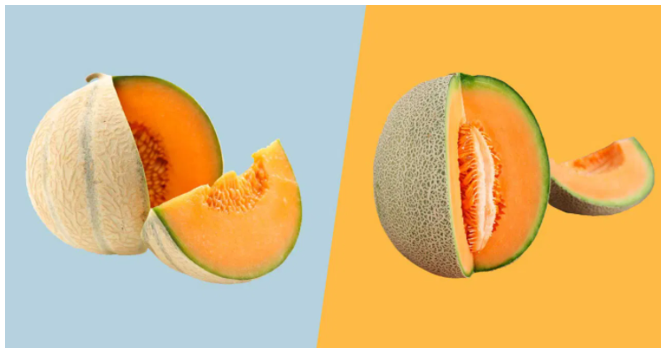Cantaloupe and Muskmelon are often confused for the same fruit. They are actually slightly different; however, both are tender, heat-loving fruits. Their growing conditions are also the same.

Muskmelon and Cantaloupe
When to Plant
- Melons may be directly seeded or started as transplants.
- They require warm soil with moderate soil moisture. Planting in mid-May in southern Minnesota and early June in the northern half of the state.
- To increase earliness, start seed for transplants 3 to 4 weeks before planting time.
- Because melons do not transplant well if the roots are disturbed, you should start seed in individual containers.
- Proper temperatures for germinating and growing the transplants are very important.
- Do not allow transplants to become too large before planting in the garden or stunting and crop delays may result.
- Sterilized media should be used for starting seed to prevent damping-off and other diseases of seeds and seedlings.
- Black plastic will heat the soil more quickly. It can also be used as a “mulch”. You can lay it down 2 to 3 weeks ahead of planting. You’ll need to make holes for planting.
Planting
- Incorporate well-rotted manure into the planting area.
- Plant seeds one inch deep and thin the seedlings 18 to 24 inches apart or the equivalent (two plants every 36 inches or three plants every 48 inches in the hill system).
- Plant transplants to their root depth and space as above.
- Space rows at least 5 feet apart.
- Use a starter fertilizer for transplants.
Care
- Apply Gertens All Purpose Plant Food or Garden-Tone when the plants begin to vine.
- Floating row covers can also be used early in the season to exclude the worst of the cold and also early season insect invaders.
- Covers need not be removed until plants start to flower unless extremely hot weather threatens.
- Melons suffer from extremes in soil moisture (too much rain or an extended drought). Irrigation is recommended in case of drought, especially when the vines are growing and the fruits are developing.
- Trickle irrigation systems used with black plastic mulch work extremely well.
- Melons ripen to the highest quality when the vines remain healthy throughout the harvest period, when temperatures are warm but not excessively high and when the weather is comparatively dry at the time of maturity.
Harvesting
Good eating quality depends upon the texture of the melons and the development of sugars from proper ripening on the vines.
- Melons are ripe when the rind changes from a green to tan or yellow between the netting.
- Pick when the stem separates easily from the vine near the point of attachment ("half-slip" or "full-slip" stages of development).
- At these stages, there will be a crack near the point of attachment.
- Do not pick too early because the quality will not be as high as that of vine-ripened melons; sugars continue to be stored in the developing melons up to the moment the stem separates.
- Once picked, muskmelons soften but do not sweeten further.
- Harvest early in the day after the plants are dry and be careful not to damage the vines.
- Pick every other day at the beginning of the season and every day at peak season.
- At peak, especially in dry seasons, wildlife and insects such as picnic beetles quickly attack the sweet, juicy, ripening and softening fruit.

Common Problems
Control cucumber beetles with an organic pesticide like Captain Jack's Deadbug Brew. They damage melons and spread bacterial wilt by feeding on the plants.
Read more on Growing Melons from the University of MN Ext.

The experts at Gertens are always available to answer your questions!

